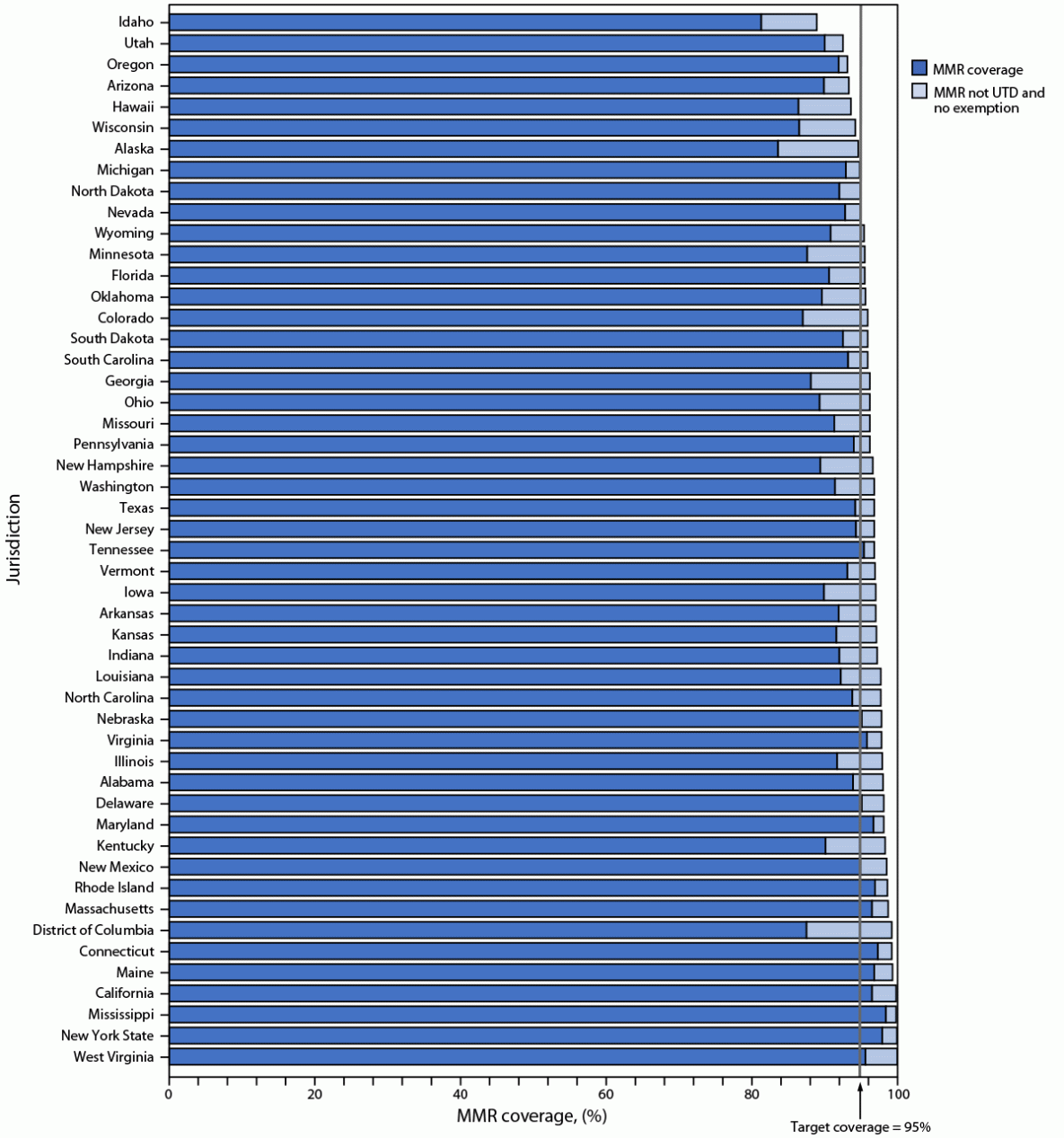According to a CDC report, the number of children whose caregivers are opting them out of routine childhood vaccinations has reached an all-time high.
“The overall percentage of children with an exemption increased from 2.6% during the 2021–22 school year to 3.0% during the 2022–23 school year, the highest exemption rate ever reported in the United States,” the CDC stated.
“During the 2022–23 school year, nationwide vaccination coverage among kindergarten children remained approximately 93% for MMR, DTaP, polio, and VAR, similar to that in the 2021–22 school year, lower than the 94% coverage in the 2020–21 school year, and lower still than the 95% coverage during the 2019–20 school year, when children were vaccinated before the COVID-19 public health emergency,” the public health agency wrote.
“National MMR coverage among kindergarten students remained below the Healthy People 2030 target of 95% for the third consecutive year. Coverage with all four vaccines declined in a majority of states,” the CDC continued.
The number of kids whose caregivers are opting them out of routine vaccines has reached an all-time high, the CDC says, potentially leaving hundreds of thousands of children unprotected against preventable diseases like measles and whooping cough. https://t.co/49S7IprIf8
— NBC News (@NBCNews) November 9, 2023
Although the percentage drop of children receiving childhood vaccinations appears small, it’s trending in a direction indicating more parents distrust vaccines and the pharmaceutical industry.
The increased distrust is distributed across the entire country, with 40 states reporting rises in exemptions for childhood vaccinations.
NBC News reports:
The report did not dive into the reasons for the increase, but experts said the findings clearly reflect Americans’ growing unease about medicine in general.
“There is a rising distrust in the health care system,” said Dr. Amna Husain, a pediatrician in private practice in North Carolina, as well as a spokesperson for the American Academy of Pediatrics. Vaccine exemptions “have unfortunately trended upward with it.”
The CDC report found that 3% of children entering kindergarten during the 2022-2023 school year were granted a vaccine exemption from their state. This is the highest exemption rate ever reported in the U.S.
Forty states saw rises in exemptions. In 10 states — Alaska, Arizona, Hawaii, Idaho, Michigan, Nevada, North Dakota, Oregon, Utah and Wisconsin — the exemption rate soared over 5%.
“This is quite a jump,” said Ranee Seither, a CDC epidemiologist and author of the new report. Just three years ago, Seither said, only two states had an exemption rate of more than 5%.
Idaho was a standout in the new report. More than 12% of children entering kindergarten in that state had a vaccine exemption in 2022.

*Image from CDC*

*Image from CDC*
“This rate will continue to grow every year mandates continue. Time to make all vaccines free choice with no need for exemptions. Drop all mandates now!” Dr. Peter McCullough said.
This rate will continue to grow every year mandates continue. Time to make all vaccines free choice with no need for exemptions. Drop all mandates now! #courageousdiscourse https://t.co/Pc4fTyZgKF pic.twitter.com/cMFLfypyFL
— Peter A. McCullough, MD, MPH™ (@P_McCulloughMD) November 10, 2023
A record number of American kindergarten students started school last year with an exemption from one of the key vaccines health authorities require, according to new data from the CDC. https://t.co/GOKrWid5jQ
— CBS News (@CBSNews) November 10, 2023
From the CDC:
The percentage of children with an exemption increased in 40 states and DC. To achieve the Healthy People 2030 target of 95% MMR coverage, exemptions cannot exceed 5%. State-level exemption rates in excess of 5% prevent 10 states from potentially achieving ≥95% MMR coverage even if all nonexempt kindergartners in 2022–23 were vaccinated, up from four states in 2021–22. National MMR coverage of 93.1% during the 2022–23 school year translates to approximately 250,000 kindergartners who are at risk for measles infection.
cont.
Nationwide vaccination coverage among kindergarten students remains below prepandemic levels, and exemptions have increased. Because clusters of undervaccinated children can lead to outbreaks (6–8), it is important for immunization programs, schools, and providers to make sure children are fully vaccinated before school entry, or before provisional enrollment periods expire. In previous years, nearly all states had the potential to achieve ≥95% coverage if all nonexempt students were vaccinated, but increases in state-level exemptions have reduced that number by 17%, from 48 in 2020–21 to 40 in 2022–23. Exemptions in excess of 5% limit the level of vaccination coverage that can be achieved, which increases the risk of outbreaks of vaccine-preventable diseases. It is not clear whether this reflects a true increase in opposition to vaccination, or if parents are opting for nonmedical exemptions because of barriers to vaccination or out of convenience. Whether because of an increase in hesitancy or barriers to vaccination, the COVID-19 pandemic affected childhood routine vaccination (9). Enforcement of school vaccination requirements, school-based vaccination clinics, reminder and recall systems, and follow-up with undervaccinated students have already been shown to be effective in increasing vaccination coverage (10). A better understanding of the reasons behind nonmedical exemptions increasing in 40 states and DC, and their impact, could help develop policies that would complement those interventions, to bring higher vaccination coverage and protection against vaccine-preventable diseases within reach of more states.
The COVID-19 plandemic and the egregious harms caused by the experimental mRNA injections woke up many people about the dangers of vaccination some have warned about for years.
It wouldn’t be a surprise to see the trend of parents opting their children out of routine vaccinations continue to increase in the coming years.







